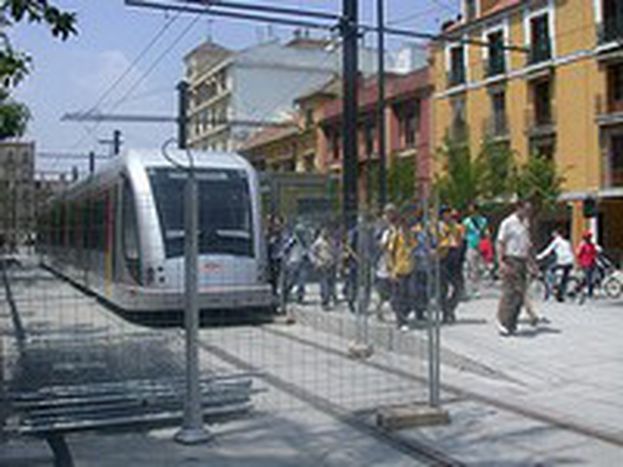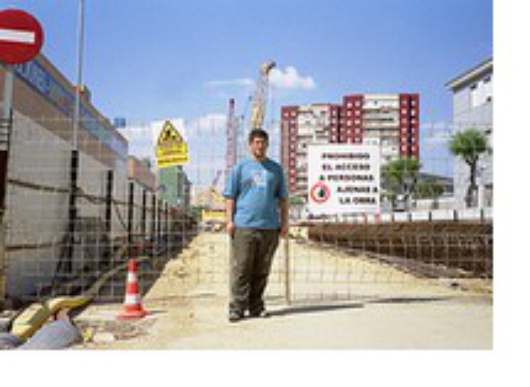
Seville: empty new metro?
Published on
Translation by:
Their first metro line, a tramway in the city centre, a car-free zone and cyclist paths: Seville’s ecological transport fights traffic
Seville, the first Sunday in May: the crowd rushes along Constitución Avenue with its gleaming new rails. The new tramway is still in its test phase; it is expected to be officially opened this autumn. Bystanders comment on a series of a hundred canvases lining the tracks of the future tramway. They belong to an artistic competition organised by the town hall to familiarise people with the new Metrocentro and the pedestrian zone in the city centre.
Other than the no-car zone in the historical centre, the Andalusian capital is undergoing a small revolution in urban transport, piloted by the mayor and regional government. ‘This is a second modernisation,’ declares Mayor Alfredo Sánchez Monteseirín. He is stepping in twelve years after the World’s Fair of 1992, which brought Seville a modern airport, motorways and three futuristic bridges on the Guadalquivir River.
More than a decade later, priorities have changed: the new transport and cyclists paths should from now on join the fight against pollution and global warming. The objectives are not very evident in a city with a predominant car culture, and where ecology far from represents a daily concern.
Controversial return
500 metres from the exposition, in front of the Alfonso XII Hotel, a wagon from the new tramway is open for visitors. The interior is placarded with a series of historical pictures; Seville already had a tram in 1887, a fact which amazes the younger crowd.
Pilar is in his sixties and runs a newspaper kiosk on Puerta de Jerez. ‘The tram was shut down in 1960,' he recalls. 'It was a shame - I found it much nicer than the new one.’ The new style has to cross one and a half kilometres, and is already at the wrong end of jibes from local residents. Complaints are that the line is too short, too expensive. Not to mention the ugliness of the poles, in place to support the electricity supply.
From now on, to cut short these unflattering commentaries, the town hall organised an information centre and does its best to reassure the locals. In a year from now, the poles will be removed and the tramways will roll autonomously, thanks to an electric battery. The rails will also be extended. Before elections took place on 27 May, the Nationalist and Conservative coalition Andalucista party had even threatened to take apart the tram if they got through (the Socialists won in the end).
Spirit of Seville
‘Sevillans love to criticise new things. But once put into place, they are content. Look at the crowd rushing along the new avenue for pedestrians,’ say Carol and Daniel. The two Sevillans are the creators of ‘Sevilla21’, a discussion forum for citizens dedicated to the city's urban transformation.
They are part of the enthusiasts in the first hour, having followed all the events in Seville's ongoing transport revolution: the discovery of an Arabic mural outside the dig for a metro station on San Fernando road, changes in the tramway's route, and drivers protesting against the pedestrian zone. Another major change was the stopping of horse-drawn carts at Virgen de los Reyes, which had been considered the best place in the city to 'trap tourists,' as Miguel confesses.
However, it’s not only the tram that has stirred up controversy. ‘The metro?' exclaims Pilar, despite the first constructions on the Puerta de Jerez at St. Bernardo: ‘over my dead body!.’ The first metro project of in Seville was actually launched in 1974 but never finished. ‘There was even stronger opposition then than there is today,’ says Daniel.
At the time, a local resident had even published a photo falsely insinuating that the tunnel would interfere with the emblematic monument of the town, the Giralda bell tower of the city's cathedral. In fact, the project was interrupted by insufficient funding.
Things are different today: the metro consortium obtained a loan of 260 million Euros from a European investment bank and reaped votes from Sevillans. Car junkies hope for a reduction in traffic jams, whilst others think that they will gain time by taking the metro.
Waiting at Dos Hermanas
 At Los Quintos, in the municipality of Dos Hermanas, the principal city dormitory of the province south of the Guadalquivir river, Seville: the metro construction site is sandwiched between various buildings and the Cinéapolis complex. 10 kilometres from the historical center, nobody imagines that the metro will have its day. Certainly not Alberto. The teenager spends at least an hour on the bus each day, and calculates that it would take him three times less the time it takes on the bus with the metro.
At Los Quintos, in the municipality of Dos Hermanas, the principal city dormitory of the province south of the Guadalquivir river, Seville: the metro construction site is sandwiched between various buildings and the Cinéapolis complex. 10 kilometres from the historical center, nobody imagines that the metro will have its day. Certainly not Alberto. The teenager spends at least an hour on the bus each day, and calculates that it would take him three times less the time it takes on the bus with the metro.
Anticipated by the end of 2008, instead of as first proposed in summer 2006, cyclists will profit from new riding paths and parking reserved along the two roads. Alberto Fernandez rides his bicycle everyday to get to work, and emphasises that Seville is ‘ideal for cyclists. The city is flat and it rarely ever rains. However, before it was too dangerous with the cars.’
Bus number 133 opened as a temporary substitute the metro between the centre and Dos Hermanas. ‘My route is almost always empty because it is in low demand amongst residents,' says its bus driver. 'What if the metro remains empty after all this work too? Sevillans,’ he adds, ‘use their cars to travel 200 metres. They couldn't care less about the environment.’ There is more than an ecological argument - it’s the cost of transport, and the time gain that will become the biggest difference.
All photos (in-text: Alberto awaits the completion of the metro, TL)
Translated from Révolution des transports



